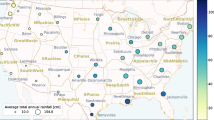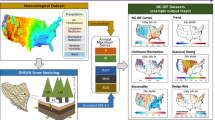Abstract
Ongoing and potential future changes in precipitation will affect water management infrastructure. Urban drainage systems are particularly vulnerable. Design standards for many stormwater practices rely on design storms based on precipitation intensity-duration-frequency (IDF) curves. In many locations, climate projections suggest relatively small changes in total precipitation volume, but increased magnitude of extreme events. We develop an approach for estimating future IDF curves that is efficient, can use widely available downscaled GCM output, and is consistent with published IDF curves for the USA that are used in local stormwater regulations and design guides. The method is GCM-agnostic and provides a relatively simple way to develop scenarios in a format directly useful to assessing risk to stormwater management infrastructure. Model biases are addressed through equidistant quantile mapping, in which the modeled change in both the location and scale of the cumulative distribution of storm events from historical to future conditions is used to adjust the extreme value fit used for IDF curve development. The approach requires only precipitation annual maxima, is readily automated, and hits a mid-point between theoretical rigor and ease of application that will be of practical use for the rapid screening of vulnerabilities across projections. We demonstrate estimation of future IDF curves at locations throughout the USA and link IDF-derived design storms to a rainfall-runoff model to evaluate the potential change in storage volume requirements for capture-based stormwater management practices by 2065.








Similar content being viewed by others
Data availability
All data are available from the corresponding author upon request.
References
Arnbjerg-Nielsen K (2012) Quantification of climate change effects on extreme precipitation used for high resolution hydrologic design. Urban Water J 9(2):57–65
Arnbjerg-Nielsen K, Willems P, Olsson J, Beecham S, Pathirana A, Bülow Gregersen I, Madssen H, Nguyen VT-V (2013) Impacts of climate change on rainfall extremes and urban drainage systems: a review. Water Sci Technol 68:16–28
Balkema AA, de Haan L (1974) Residual life time at great age. Ann Probab 2(5):792–804
Berndtsson JC (2010) Green roof performance towards management of runoff water quantity and quality: a review. Ecol Eng 36:351–360
Cannon AJ, Innocenti S (2019) Projected intensification of sub-daily and daily rainfall extremes in convection-permitting climate model simulations over North America: implications for future intensity-duration-frequency curves. Nat Hazards Earth Syst Sci 19:421–440
Castellano CM, DeGaetano AT (2017) Downscaling extreme precipitation from CMIP5 simulations using historical analogs. J App Meteorol 56:2421–2439
Cheng L, AghaKouchak A (2014) Nonstationary precipitation intensity-duration frequency curves for infrastructure design in a changing climate. Sci Rep 4:7093. https://doi.org/10.1038/srep07093
Claytor RA, Schueler TR (1996) Design of stormwater filtering systems. Chesapeake Research Consortium, Inc. Solomons, MD
Cook LM, Anderson CJ, Samaras C (2017) Framework for incorporating downscaled climate output into existing engineering methods: application to precipitation frequency curves. Australas J Inf Syst 23(4). https://doi.org/10.1061/(ASCE)IS.1943-555X.0000382
Cook LM, McGinnis S, Samaras C (2020) The effect of modeling choices on updating intensity-duration-frequency curves and stormwater infrastructure designs for climate change. Clim Chang 159:289–308. https://doi.org/10.1007/s10584-019-02649-6
Dahm R, Bhardwaj A, Weiland FS, Corzo G, Bouwer LM (2019) A temperature-scaling approach for projecting changes in short duration rainfall extremes from GCM data. Water 11:313. https://doi.org/10.3390/w11020313
Fadhel S, Rico-Ramirez MA, Han D (2017) Uncertainty of intensity-duration-frequency (IDF) curves due to varied climate baseline periods. J Hydrol 547:600–612. https://doi.org/10.1016/j.jhydrol.2017.02.013
Fowler HJ, Kilsby CG, O’Connell PE, Burton A (2005) A weather-type conditioned multi-site stochastic rainfall model for the generation of scenarios of climatic variability and change. J Hydrol 308(1–4):50–66
Gallo C, Moore A, Wywrot J (2012) Comparing the adaptability of infiltration based BMPs to various U.S. regions. Landsc Urban Plan 106(4):326–335
Galloway GE (2011) If stationarity is dead, what do we do now? J Am Water Resour Assoc 47(3):563–570. https://doi.org/10.1111/j.1752-1688.2011.00550.x
Hayhoe K, Wuebbles DJ, Easterling DR, Fahey DW, Doherty S, Kossin J, Sweet W, Vose R, Wehner M (2018) Our changing climate. In Impacts, Risks, and Adaptation in the United States: Fourth National Climate Assessment, Volume II [Reidmiller, D.R., C.W. Avery, D.R. Easterling, K.E. Kunkel, K.L.M. Lewis, T.K. Maycock, and B.C. Stewart (eds.)]. U.S. Global Change Research Program, Washington, DC. https://doi.org/10.7930/NCA4.2018.CH2
Hollebrandse FAP, Gillespie S, Asquith W (2015) lmoments3 Library Documentation, Release 1.0.2. https://buildmedia.readthedocs.org/media/pdf/lmoments3/latest/lmoments3.pdf, accessed 8/21/2019
Hosking JRM, Wallis JR (1997) Regional frequency analysis, an approach based on L-moments. Cambridge University Press
Huard D, Mailhot A, Duchesne S (2010) Bayesian estimation of intensity-duration-frequency curves and of the return period associated to a given rainfall event. Stoch Environ Risk Assess 24:337–347
Hunt WF, Davis AP, Traver RG (2012) Meeting hydrologic and water quality goals through targeted bioretention design. J Environ Eng 138(6):698–707
Kadlec RH, Knight RL (1996) Treatment wetlands. Lewis Publishers, Boca Raton
Kao S-C, Ganguly AR (2011) Intensity, duration, and frequency of precipitation extremes under 21st-century warming scenarios. J Geophys Res 116:D16119. https://doi.org/10.1029/2010JD015529
Khan UT, Valeo C, Chu A, van Duin B (2012) Bioretention cell efficacy in cold climates: part 1—hydrologic performance. Can J Civil Eng 39(11):1210–1221
Kilgore RT, Herrmann G, Thomas Jr WO, Thompson DB (2016) Highways in the river environment–floodplains, extreme events, risk, and resilience. Hydraulic Engineering Circular No. 17, 2nd Edition. FHWA-HIF-16-018. U.S. Department of Transportation, Federal Highway Administration, Washington, DC. https://www.fhwa.dot.gov/engineering/hydraulics/pubs/hif16018.pdf, accessed 12/13/19
Kilsby CG, Jones PD, Burton A, Ford AC, Fowler HJ, Harpham C, James P, Smith PA, Wilby RL (2007) A daily weather generator for use in climate change studies. Environ Modell Softw 22:1705–1719
Kristvik E, Johannessen BG, Muthanna TM (2019) Temporal downscaling of IDF curves applied to future performance of local stormwater measures. Sustainability 11:1231. https://doi.org/10.3390/su11051231
Li H, Sheffield J, Wood EF (2010) Bias correction of monthly precipitation and temperature fields from Intergovernmental Panel on Climate Change AR4 models using equidistant quantile matching. J Geophys Res: Atmos 115:D10101. https://doi.org/10.1029/2009JD012882
Li J, Evans J, Johnson F, Sharma A (2017) A comparison of methods for estimating climate change impact on design rainfall using a high-resolution RCM. J Hydrol 547:413–427
MDE (2009) 2000 Maryland Stormwater Design Manual, Volumes I and II (Revised May 2009). Maryland Dept. of the Environment (MDE). https://mde.maryland.gov/programs/Water/StormwaterManagementProgram/Pages/stormwater_design.aspx, accessed 12/13/19
MDOT (2006) Drainage manual. Michigan Department of Transportation. https://www.michigan.gov/documents/MDOT_MS4_Chap_91716_7._03_Drainage_Manual.pdf. accessed 12/13/19
Mehran A, AghaKouchak A, Philips TJ (2014) Evaluation of CMIP5 continental precipitation simulations relative to satellite-based gauge-adjusted observations. J Geophys Res Atmos 119:1695–1707. https://doi.org/10.1002/2013JD021152
Milly PCD, Betancourt J, Falkenmark M, Hirsch RM, Kundzewicz ZW, Lettenmaier DP, Stouffer RJ (2008) Stationarity is dead: whither water management? Science 319:573–574. https://doi.org/10.1126/science.1151915
NRCS (1986) Urban hydrology for small watersheds. TR-55. U.S. Dept. of Agriculture, Natural Resources Conservation Service
NYC-MORR (2019) Climate resiliency design guidelines, version 3.0. New York City Mayor’s Office of Recovery and Resilience. https://www1.nyc.gov/assets/orr/pdf/NYC_Climate_Resiliency_Design_Guidelines_v3-0.pdf, accessed 12/13/19
Onof C, Arnbjerg-Nielsen K (2009) Quantification of anticipated future changes in high resolution design rainfall for urban areas. Atmos Res 92(3):350–363
Panofsky HA, Brier GW (1968) Some applications of statistics to meteorology. Pennsylvania State University, University Park
Perica S, Martin D, Pavlovic S, Roy I, St. Laurent M, Trypaluk C, Unruh D, Yekta M, Bonnin G (2013) Precipitation-frequency Atlas of the United States. NOAA Atlas No. 14, Volume 8 Version 2.0: Midwestern States (Colorado, Iowa, Kansas, Michigan, Minnesota, Missouri, Nebraska, North Dakota, Oklahoma, South Dakota, Wisconsin). National Oceanic and Atmospheric Administration, Silver Spring, MD. http://www.nws.noaa.gov/oh/hdsc/currentpf.htm
Pickands J III (1975) Statistical inference using extreme order statistics. Ann Stat 3(1):119–131
Pierce DW, Cayan DR, Thrasher BL (2014) Statistical downscaling using localized constructed analogs (LOCA). J Hydrometeorol 15:2558–2585. https://doi.org/10.1175/JHM-D-14-0082.1
Prodanovic P, Simonovic SP (2007) Development of rainfall intensity duration frequency curves for the city of London under the changing climate. Water Resources Research Report No. 058. The University of Western Ontario, Dept. of Civil and Environmental Engineering, London, Ontario
Ragno E, AghaKouchak A, Love CA, Cheng L, Vahedifard F, Lima CHR (2018) Quantifying changes in future intensity-duration-frequency curves using multimodel ensemble dimulations. Water Resour Res 54(3):1751–1764
Roseen RM, Ballestero TP, Houle JJ, Avellaneda P, Briggs J, Fowler G, Wildey R (2009) Seasonal performance variations for storm-water management systems in cold climate conditions. J Environ Eng 135:128–137
Rosenberg, EA, Keys PW, Booth DB, Hartley D, Burkey J, Steinemann AC,·Lettenmaier DP (2010) Precipitation extremes and the impacts of climate change on stormwater infrastructure in Washington State. Clim Chang 102:319–349 doi https://doi.org/10.1007/s10584-010-9847-0
Rossman L (2015) Storm water management model, user’s manual version 5.1. EPA 600/R-14/413b. National Risk Management Laboratory, Office of Research and Development, U.S. Environmental Protection Agency, Cincinnati, OH
Serinaldi F, Kilsby CG (2014) Rainfall extremes: toward reconciliation after the battle of distributions. Water Resour Res 50:336–352. https://doi.org/10.1102/2013WR014211
Shrestha A, Babel MS, Weesakul S, Vojinovic Z (2017) Developing Intensity-Duration-Frequency (IDF) curves under climate change uncertainty: the case of Bangkok, Thailand. Water 9:145. https://doi.org/10.3390/w9020145
Sillmann J, Kharin VV, Zhang X, Zwiers FW, Bronaugh D (2013) Climate extremes indices in the CMIP5 multimodel ensemble: part 1. Model evaluation in the present climate. J Geophys Res Atmos 118:1716–1733. https://doi.org/10.1002/jgrd.50203
Srivastav RK, Schardong A, Simonovic SP (2014a) Equidistance quantile matching method for updating IDF curves under climate change. Water Resour Manag. https://doi.org/10.1007/s11269-014-0626-y
Srivastav RK, Schardong A, Simonovic SP (2014b) Computerized tool for the development of intensity-duration-frequency curves under a changing climate. Water Resources Research Report 089, University of Western Ontario, Dept. of Civil and Environmental Engineering, London, Ontario
Sun Y, Solomon S, Dai A, Portmann R (2006) How often does it rain? J Clim 19:916–934. https://doi.org/10.1175/JCLI3672.1
USGCRP (2017) Climate science special report: fourth national climate assessment, Volume I [Wuebbles DJ, Fahey DW, Hibbard KA, Dokken DJ, Stewart BC, Maycock TK (eds.)]. U.S. Global Change Research Program, Washington, DC, USA, 470 pp, https://doi.org/10.7930/J0J964J6
VA DCR (1999) Virginia stormwater management handbook, First Edition, Volume 2. Virginia Department of Conservation and Recreation, Division of Soil and Water Conservation, Richmond, VA. https://www.deq.virginia.gov/Portals/0/DEQ/Water/StormwaterManagement/SWMHandbookVolume%20II.pdf, accessed 12/13/19
Willems P, Vrac M (2011) Statistical precipitation downscaling for small-scale hydrological impact investigations of climate change. J Hydrol 402:193–205
Zhu J (2012) Impact of climate change on extreme rainfall across the United States. J Hydrol Eng 18(10):1301–1309. https://doi.org/10.1061/(ASCE)HE.1943-5584.0000725
Acknowledgments
We acknowledge the World Climate Research Programme’s Working Group on Coupled Modeling, which is responsible for CMIP5, and we thank these modeling groups for producing and making available their model output. For CMIP5, the US Department of Energy’s Program for Climate Model Diagnosis and Intercomparison provides coordinating support and led development of software infrastructure in partnership with the Global Organization for Earth System Science Portals.
Funding
Funding for this research was provided by the US Environmental Protection Agency Office of Research and Development.
Author information
Authors and Affiliations
Contributions
J. Butcher and T. Zi developed the theoretical approach. J. Butcher wrote the paper. T. Zi, B. Groza, B. Pickard, and S. Job developed and implemented the Python code. T. Johnson provided funding, guidance, and editorial review.
Corresponding author
Ethics declarations
Conflict of interest
The authors declare that they have no conflict of interest.
Disclaimer
The views expressed in this paper represent those of the authors and do not necessarily reflect the views or policies of the US Environmental Protection Agency.
Code availability
Python scripts for implementing the methods described in this paper are available upon request from the corresponding author.
Additional information
Publisher’s note
Springer Nature remains neutral with regard to jurisdictional claims in published maps and institutional affiliations.
Rights and permissions
About this article
Cite this article
Butcher, J.B., Zi, T., Pickard, B.R. et al. Efficient statistical approach to develop intensity-duration-frequency curves for precipitation and runoff under future climate. Climatic Change 164, 3 (2021). https://doi.org/10.1007/s10584-021-02963-y
Received:
Accepted:
Published:
DOI: https://doi.org/10.1007/s10584-021-02963-y




